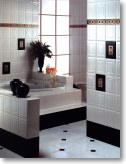|
|
|
||
ceramic tile quality
Determining Tile Quality
Tile quality is the next step to consider after you've determined the wear rating. You might be wondering 'how can a novice possibly know what to look for, when judging the quality of a particular tile'? That's precisely what this article is designed to do, specifically tell you what factors are involved and how you as a consumer can easily identify them. Here are some basic questions to ask yourself. First
and foremost, how does the tile 'look' to you? Are there any visible
things in the sample you are looking at, such as blotches and blemishes,
that are obvious? When looking at the design pattern, is it distinct or
muted? Is the color consistent throughout the entire surface? If the
tile passes your aesthetic scrutiny, it is now time to look further. Next, you'll need to determine if the individual tiles within a particular dye-lot are calibrated (sized) properly. Dye-lot is a batch of tile manufactured from the same 'run' and is identified by a number on the individual cartons that should be the same on all cartons. To determine the calibration, simply take a representative sample of lets say 9 tiles from the shipment and lay them out on the floor, edge to edge, one right next to another. You should now have 3 rows of 3 tiles each laid out in front of you. Are they consistently the same size? Look carefully and see if there is not a substantial difference in size from one tile to the next. They should vary no more than 1/32 of an inch. This step is vital because it will determine what size grout lines the mechanic uses when he installs the floor. The more calibrated the shipment is, the closer the grout lines. Conversely, if the tiles vary in size, the larger (wider) the lines have to be. While the 9 pieces are on the floor in front of you, now would be a good time to check to see if there are any glaze cracks (what looks like lizard tails) visible on the tiles surface. If the tiles are not calibrated and you can see small cracks in the glaze, you can rightly assume that this is not a good quality tile selection. Once you determine what tile you want to purchase, the next step is choosing the right grout type and color. Our article 'Proper Grout Selection' will assist you in this endeavor.
� 2010 FloorBiz, Inc. All Rights Reserved Flooring | Flooring Guide | Flooring Info | Flooring Forum
| |||
|
|
|